Intestinal obstruction repair - series
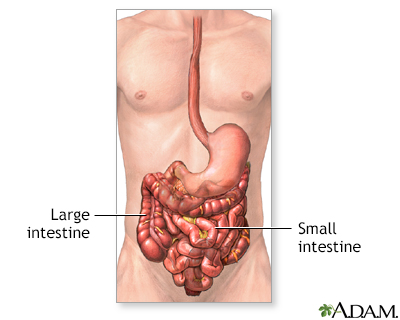
Normal anatomy
The intestine is made up of the small intestine and the large intestine (colon). The small intestine runs from the stomach to the large intestine. The colon runs from the end of the small intestine to the anus. The intestine absorbs nutrients and water from the diet.
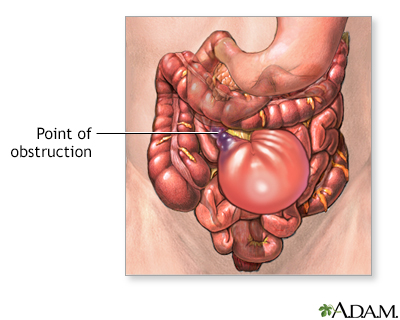
Indication, part 1
Obstruction of the intestine occurs when food and water cannot pass through the intestine. The area of intestine nearest to the obstruction becomes dilated and non-functioning. If the obstruction is not relieved, it can lead to intestinal gangrene and perforation.
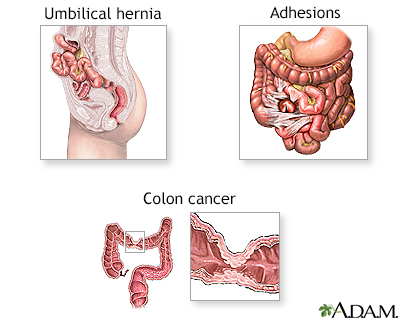
Indication, part 2
The most common causes of intestinal obstruction in adults are adhesions, hernias, and colon cancer. Adhesions are scars that form between loops of intestine, usually caused by prior surgery, which causes such scar formation. Hernias are areas of weakness in the abdominal wall, through which loops of intestine can slip and become trapped. Colon cancer is one of the most common forms of cancer. While each reason for intestinal obstruction requires a different treatment, all intestinal obstructions are potentially life-threatening.
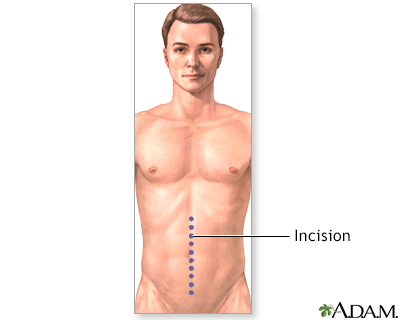
Incision
In most cases, surgery is necessary. While the patient is deep asleep and pain-free (general anesthesia), an incision is made in the midline of the abdomen. In the case of adhesions, the adhesion is removed, thus relieving the obstruction. In the case of a hernia, the hernia is repaired. If colon cancer is present, cancerous areas are removed, which also relieves the obstruction.
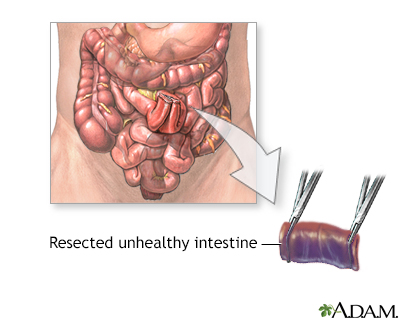
Procedure
In all cases, the intestine involved in the obstruction is examined. If any parts of the intestine look unhealthy from lack of blood flow during the period of obstruction, they are removed and the healthy ends are reconnected. A patient's recovery depends on several factors, including the cause of the intestinal obstruction and the length of time prior to relief of the obstruction.
BACK TO TOP
Review Date: 2/28/2022
Reviewed By: Debra G. Wechter, MD, FACS, General Surgery Practice Specializing in Breast Cancer, Virginia Mason Medical Center, Seattle, WA. Also reviewed by David Zieve, MD, MHA, Medical Director, Brenda Conaway, Editorial Director, and the A.D.A.M. Editorial team.

Health Content Provider
06/01/2025
|
A.D.A.M., Inc. is accredited by URAC, for Health Content Provider (www.urac.org). URAC's accreditation program is an independent audit to verify that A.D.A.M. follows rigorous standards of quality and accountability. A.D.A.M. is among the first to achieve this important distinction for online health information and services. Learn more about A.D.A.M.'s editorial policy, editorial process and privacy policy. A.D.A.M. is also a founding member of Hi-Ethics. This site complied with the HONcode standard for trustworthy health information from 1995 to 2022, after which HON (Health On the Net, a not-for-profit organization that promoted transparent and reliable health information online) was discontinued. |
The information provided herein should not be used during any medical emergency or for the diagnosis or treatment of any medical condition. A licensed medical professional should be consulted for diagnosis and treatment of any and all medical conditions. Links to other sites are provided for information only -- they do not constitute endorsements of those other sites. © 1997- 2024 A.D.A.M., a business unit of Ebix, Inc. Any duplication or distribution of the information contained herein is strictly prohibited.
